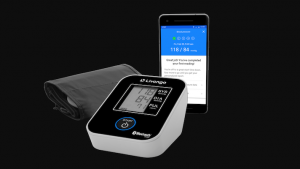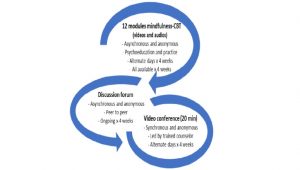Mindfulness Trained Over the Internet Improves Stress Management in Healthy Adults
By John M. de Castro, Ph.D.
“mindfulness gently builds an inner strength, so that future stressors have less impact on our happiness and physical well-being.” – Shamash Alidina
Mindfulness training has been shown to be effective in improving physical and psychological health. One reason for these benefits is that mindfulness training improves the individual’s physical and psychological reactions to stress. Stress is an integral part of life, that is actually essential to the health of the body. In moderation, it is healthful, strengthening, and provides interest and fun to life. If stress, is high or is prolonged, however, it can be problematic. It can significantly damage our physical and mental health and even reduce our longevity, leading to premature deaths.
It is important that we develop methods to either reduce or control high or prolonged stress or reduce our responses to it. Mindfulness practices have been found routinely to reduce the psychological and physiological responses to stress. and this appears to be important for health. The vast majority of the mindfulness training techniques, however, require a trained teacher. The participants must be available to attend multiple sessions at particular scheduled times that may or may not be compatible with busy employee schedules and at locations that may not be convenient. As an alternative, training over the internet has been developed. This has tremendous advantages in decreasing costs, making training schedules much more flexible, and eliminating the need to go repeatedly to specific locations. But the question arises as to the effectiveness of this approach in inducing mindfulness and reducing stress and improving psychological well-being in healthy individuals in real-world work settings.
The evidence has been accumulating. So, it is reasonable to step back and summarize what has been learned about the effects of mindfulness provided over the internet on the individual’s ability to manage stress. In today’s Research News article “A meta-analysis: Internet mindfulness-based interventions for stress management in the general population.” (See summary below or view the full text of the study at: https://www.ncbi.nlm.nih.gov/pmc/articles/PMC7360300/) Zhang and colleagues reviewed, summarized, and performed a meta-analysis of the published research controlled trials investigating the effects of mindfulness training provided over the internet on the management of stress in healthy participants. They identified 16 controlled trials.
They report that the published research found that mindfulness training of healthy participants provided over the internet produced significant increases in mindfulness and significant decreases in perceived stress with moderate effect sizes and significant decreases in anxiety and depression with small effect sizes. These results occurred regardless of the method of delivery of mindfulness training and whether students, staff, or both were the subjects. In addition, they found that when therapist guidance was present the effect sizes were larger.
It has been well established the mindfulness training decreases perceived stress, anxiety, and depression in a variety of healthy and ill populations and with a variety of delivery methods. The present meta-analysis demonstrates that mindfulness training over the internet is effective in improving stress management and mental health in healthy individuals. The results also suggest that having some guidance from a therapist provided along with the internet-based training improves the effectiveness of the treatments.
These results suggest that mindfulness training is widely effective and can be delivered cheaply and conveniently to large numbers of geographically diffuse populations. Since, stress is so ubiquitous in modern society, mindfulness training may be a way to counter the effects of that stress on physical and mental health.
So, mindfulness trained over the internet improves stress management in healthy adults.
“Learning how to accept your present-moment experience is really important for reducing stress. It seems to be a key element of mindfulness training.” – Emily Lindsay
CMCS – Center for Mindfulness and Contemplative Studies
This and other Contemplative Studies posts are also available on Google+ https://plus.google.com/106784388191201299496/posts and on Twitter @MindfulResearch
Study Summary
Zhang, Y., Xue, J., & Huang, Y. (2020). A meta-analysis: Internet mindfulness-based interventions for stress management in the general population. Medicine, 99(28), e20493. https://doi.org/10.1097/MD.0000000000020493
Abstract
Background:
Psychological stress was an important mental health problem among the general population and warrant research to inform strategies for effective prevention. iMBIs provide a possibility to offer easily accessible, efficacious, convenient, and low-cost interventions on a wide scale. However, the efficacy of iMBIs in the general population remains unclear. The aim of this meta-analysis is to evaluate the effects of iMBIs for stress reduction in the general population.
Methods:
A systematic search in PubMed, Embase, Web of Science, Medline, Cochrane Library, CNKI, and Wanfang Data databases was performed up to April 10, 2019. The overall effect sizes of the iMBIs on stress, depression, anxiety, and mindfulness were recorded by the metric of Hedges’ g with 95% confidence interval (CI), Z-value, and P value.
Results:
Sixteen eligible studies were included in the meta-analysis. The overall results indicated that iMBIs had small to moderate effects on stress (Hedges’ g = −0.393) and mindfulness (Hedges’ g = −0.316) compared with the control group. Results from subgroup analyses revealed that the type of sample and delivery mode had a greater impact on heterogeneity across the studies. Meta-regression found that the overall effect might be moderated by guidance for iMBIs.
Conclusion:
The present meta-analysis suggested that iMBIs had small to moderate effects in reducing stress and improving mindfulness of the general population in comparison with the control group. Future research is needed to explore how iMBIs are remolded to improve adherence and suit specific individuals.
https://www.ncbi.nlm.nih.gov/pmc/articles/PMC7360300/









